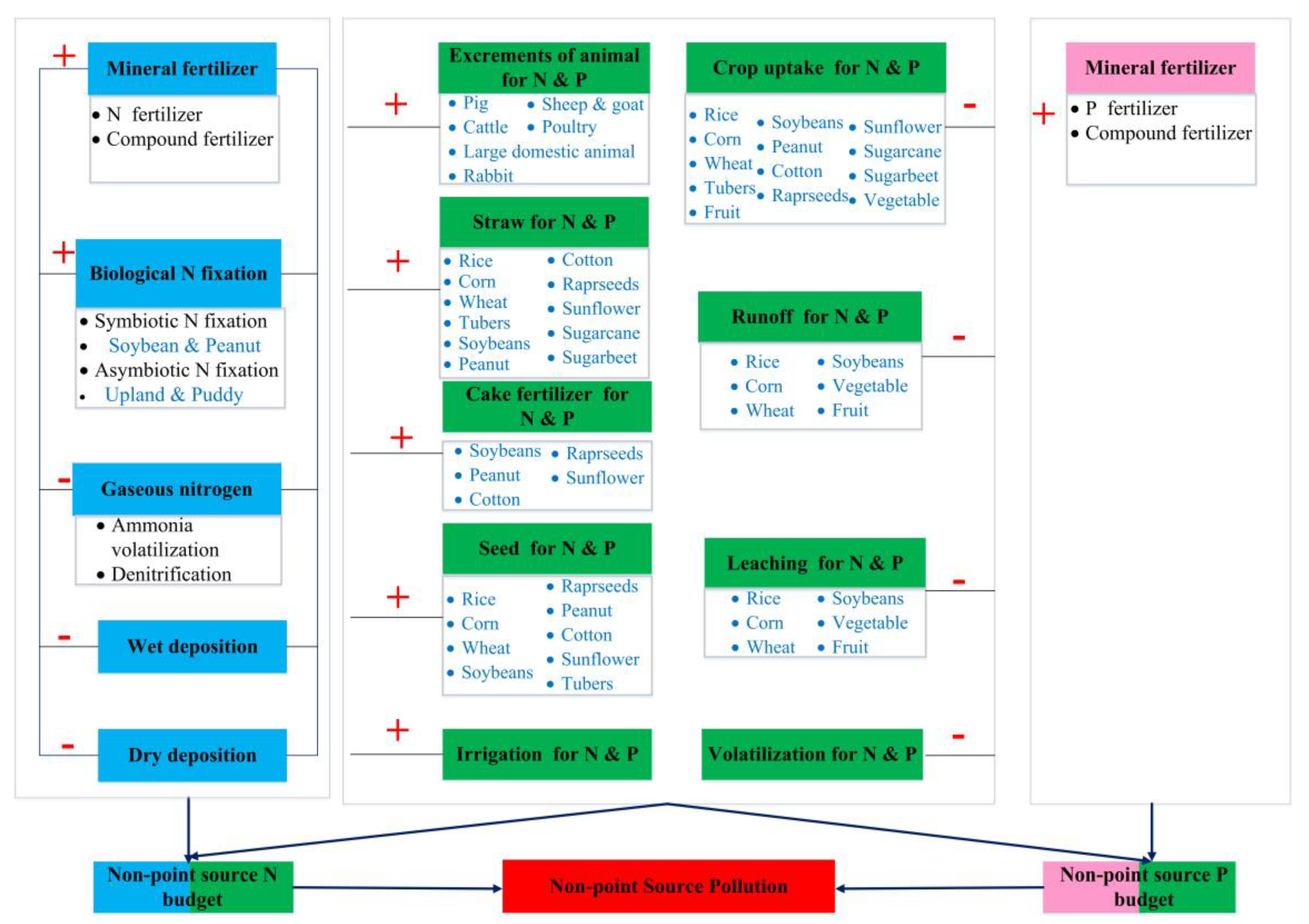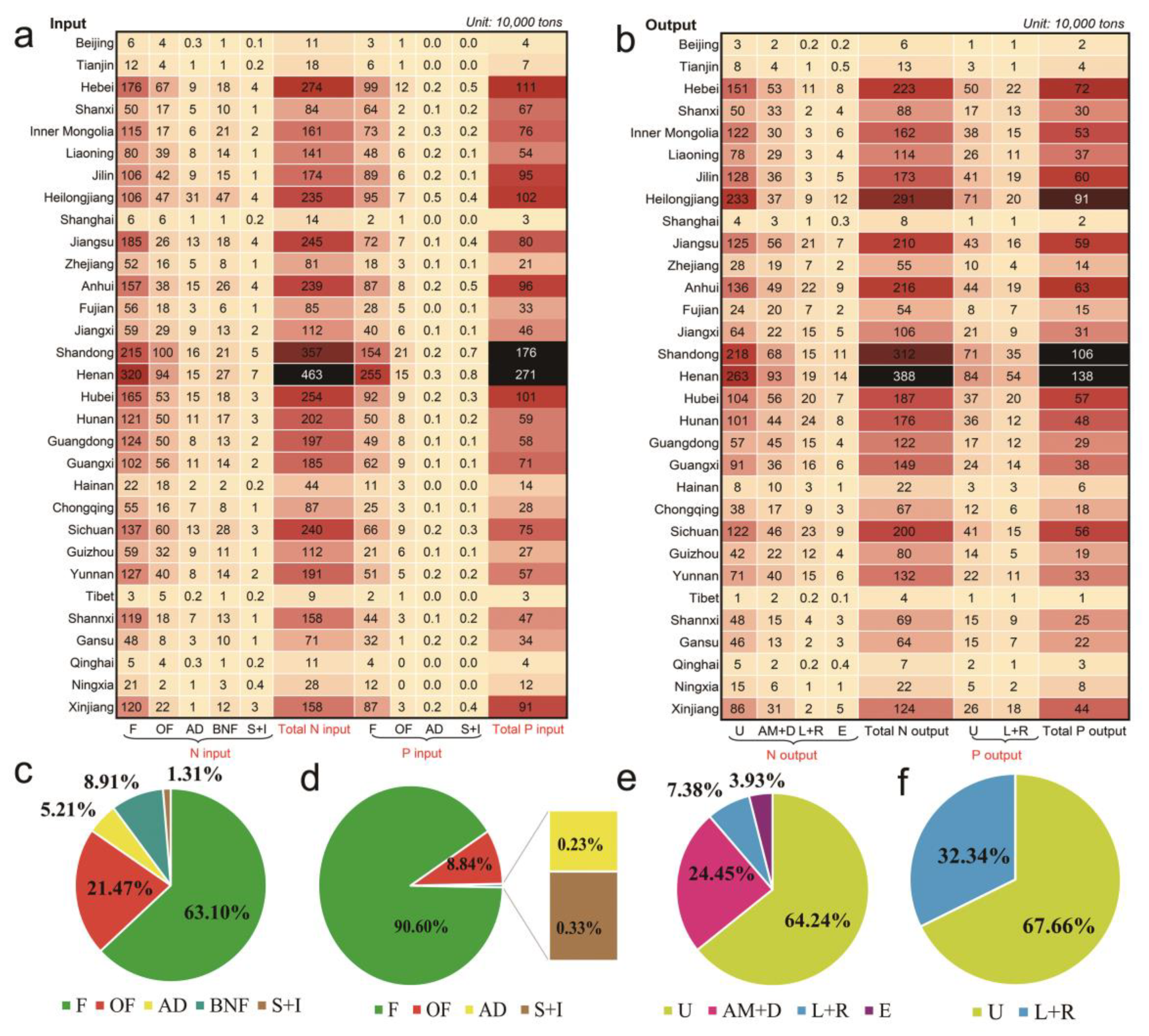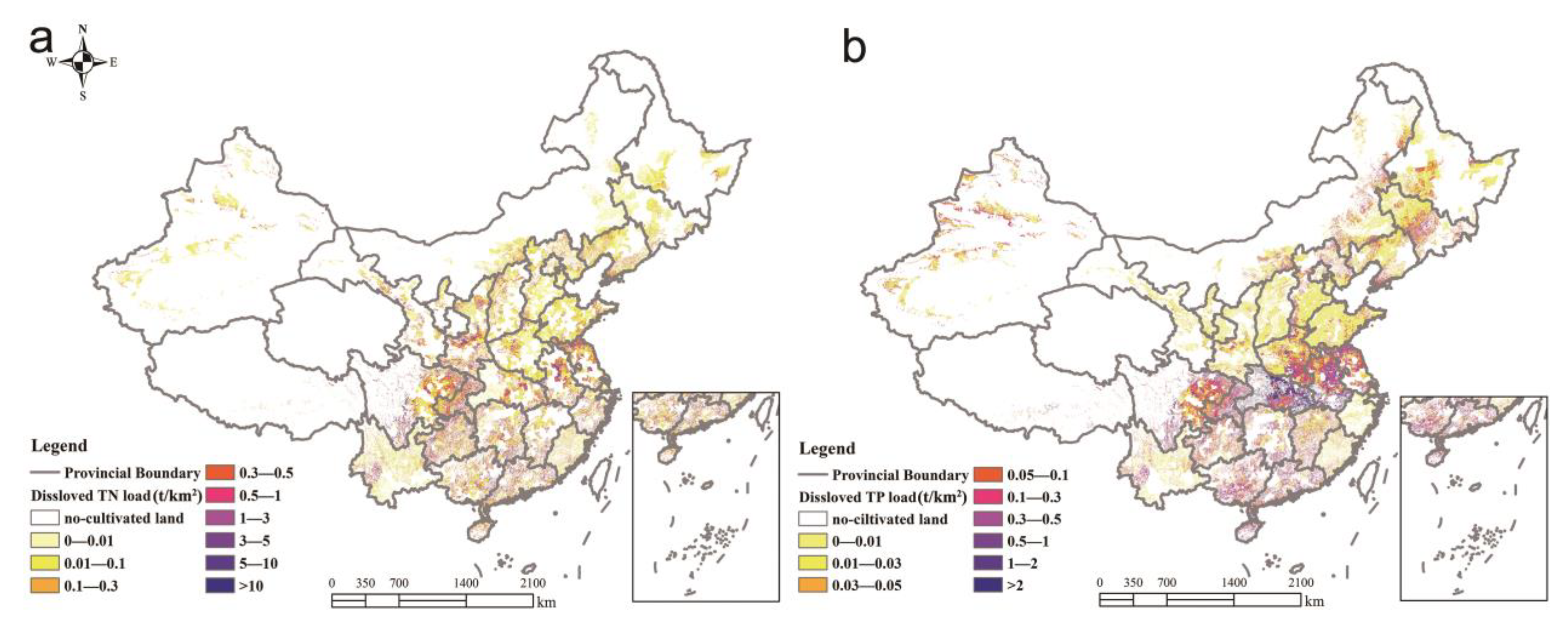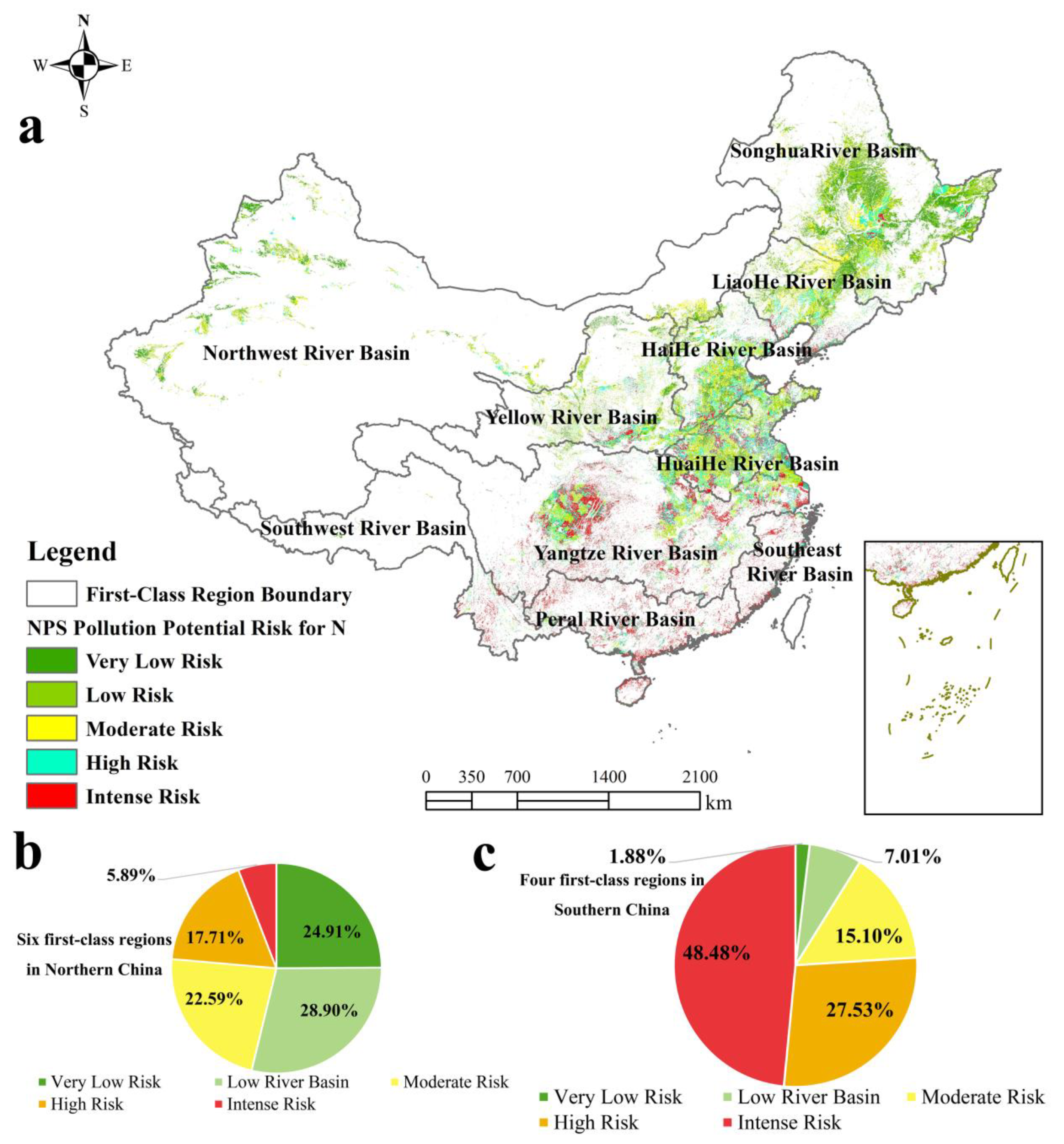Evaluating Nationwide Non-Point Source Pollution of Crop Farming and Related Environmental Risk in China
Abstract
:1. Introduction
2. Materials and Methods
2.1. Model Description
2.1.1. Nutrient Input/Output and Balance
2.1.2. NPS Pollutant Loads
2.2. Potential Pollution Risk Assessment
2.3. Data Sources
3. Results
3.1. Nutrient Balance
3.1.1. Input and Output
3.1.2. Nutrient Balance
3.2. Spatial and Temporal Distribution of Non-Point Pollution
3.3. Potential Pollution Risk of NPS
4. Discussion
4.1. Uncertainty Analysis of the Results
4.2. Severe Challenge for NPS Prevention
4.3. Management Implications
5. Conclusions
Supplementary Materials
Author Contributions
Funding
Data Availability Statement
Acknowledgments
Conflicts of Interest
References
- Fan, L.; Yuan, Y.; Ying, Z.; Lam, S.K.; Liu, L.; Zhang, X.; Liu, H.; Gu, B. Decreasing farm number benefits the mitigation of agricultural non-point source pollution in China. Environ. Sci. Pollut. Res. Int. 2019, 26, 464–472. [Google Scholar] [CrossRef] [PubMed]
- Lian, H.; Lei, Q.; Zhang, X.; Yen, H.; Wang, H.; Zhai, L.; Liu, H.; Huang, J.-C.; Ren, T.; Zhou, J.; et al. Effects of anthropogenic activities on long-term changes of nitrogen budget in a plain river network region: A case study in the Taihu Basin. Sci. Total Environ. 2018, 645, 1212–1220. [Google Scholar]
- Zhang, W.; Li, X.; Swaney, D.P.; Du, X. Does food demand and rapid urbanization growth accelerate regional nitrogen inputs? J. Clean. Prod. 2016, 112, 1401–1409. [Google Scholar] [CrossRef]
- Ongley, E.D.; Xiaolan, Z.; Tao, Y. Current status of agricultural and rural non-point source Pollution assessment in China. Environ. Pollut. 2010, 158, 1159–1168. [Google Scholar] [CrossRef] [PubMed]
- Fu, B. Editorial: Blue Skies for China. Science 2008, 321, 611. [Google Scholar]
- Panayotou, T. Empirical tests and policy analysis of environmental degradation at different stages of economic development. Pac. Asian J. Energy 1993, 4, 1–42. [Google Scholar]
- Sadik-Zada, E.R.; Gatto, A. Grow first, clean up later? Dropping old paradigms and opening up new horizons of sustainable development. Sustainability 2023, 15, 3595. [Google Scholar] [CrossRef]
- Sadik-Zada, E.R.; Gatto, A. The puzzle of greenhouse gas footprints of oil abundance. Socioecon. Plann. Sci. 2021, 75, 100936. [Google Scholar] [CrossRef]
- Aslam, B.; Hu, J.S.; Hafeez, M.; Ma, D.Q.; AlGarni, T.S.; Saeed, M.; Abdullah, M.A.; Hussain, S. Applying environmental kuznets curve framework to assess the nexus of industry, globalization, and CO2 emission. Environ. Technol. Innov. 2021, 21, 101377. [Google Scholar] [CrossRef]
- Sun, B.; Zhang, L.; Yang, L.; Zhang, F.; Norse, D.; Zhu, Z. Agricultural non-point source pollution in China: Causes and mitigation measures. Ambio 2012, 41, 370–379. [Google Scholar] [CrossRef] [Green Version]
- Yang, J.; Lin, Y. Spatiotemporal evolution and driving factors of fertilizer reduction control in Zhejiang Province. Sci. Total Environ. 2019, 660, 650–659. [Google Scholar] [CrossRef] [PubMed]
- Zhu, N.; Cao, B.; Qin, F. Research of wheat production efficiency based on fertilizer reduction potential and carbon emission reduction. China Environ. Sci. 2018, 38, 784–791. [Google Scholar]
- Zhang, J.; Beusen, A.H.W.; van Apeldoorn, D.F.; Mogollón, J.M.; Yu, C.; Bouwman, A.F. Spatiotemporal dynamics of soil phosphorus and crop uptake in global cropland during the twentieth century. Biogeosciences 2017, 14, 2055–2068. [Google Scholar] [CrossRef]
- Chen, M.; Sun, F.; Shindo, J. China’s agricultural nitrogen flows in 2011: Environmental assessment and management scenarios. Resour. Conserv. Recycl. 2016, 111, 10–27. [Google Scholar] [CrossRef]
- Yu, C.; Huang, X.; Chen, H.; Godfray, H.C.J.; Wright, J.S.; Hall, J.W.; Gong, P.; Ni, S.Q.; Qiao, S.C.; Huang, G.R.; et al. Managing nitrogen to restore water quality in China. Nature 2019, 567, 516–520. [Google Scholar] [CrossRef]
- Zhang, L.; Wang, Z.; Chai, J.; Fu, Y.; Wei, C.; Wang, Y. Temporal and Spatial Changes of Non-Point Source N and P and Its Decoupling from Agricultural Development in Water Source Area of Middle Route of the South-to-North Water Diversion Project. Sustainability 2019, 11, 895. [Google Scholar] [CrossRef] [Green Version]
- Santhi, C.; Arnold, J.G.; Williams, J.R.; Dugas, W.A.; Srinivasan, R.; Hauck, L.M. Validation of the SWAT Model on a Large River Basin with Point and Nonpoint Sources. JAWRA 2010, 37, 1169–1188. [Google Scholar]
- Berka, C.; Schreier, H.; Hall, K. Linking water quality with agricultural intensification in a rural watershed. Water Air Soil Pollut. 2001, 127, 389–401. [Google Scholar] [CrossRef]
- Wang, X.; Hao, F.; Cheng, H.; Yang, S.; Zhang, X.; Bu, Q. Estimating non-point source pollutant loads for the large-scale basin of the Yangtze River in China. Environ. Earth Sci. 2011, 63, 1079–1092. [Google Scholar] [CrossRef]
- Wang, X.; Wang, Q.; Wu, C.; Liang, T.; Zheng, D.; Wei, X. A method coupled with remote sensing data to evaluate non-point source pollution in the Xin’anjiang catchment of China. Sci. Total Environ. 2012, 430, 132–143. [Google Scholar] [CrossRef]
- Guo, H.; Wang, X.; Zhu, J. Quantification and Index of Non-Point Source Pollution in Taihu Lake Region with GIS. Environ. Geochem. Health 2004, 26, 147–156. [Google Scholar] [CrossRef] [PubMed]
- Zhang, Q.-L.; Chen, Y.-X.; Jilani, G.; Shamsi, I.H.; Yu, Q.-G. Model AVSWAT apropos of simulating non-point source pollution in Taihu lake basin. J. Hazard. Mater. 2010, 174, 824–830. [Google Scholar] [CrossRef] [PubMed]
- Wu, C.; Deng, G.C.; Li, Y.; Li, Z.Y.; Yang, S.H. Study on the Risk Pattern of Non-Point Source Pollution Using GIS Technology in the Dianchi Lake Watershed. Adv. Mater. Res. 2012, 356–360, 771–776. [Google Scholar] [CrossRef]
- Xing, K.; Guo, H.; Sun, Y.; He, B.; Huang, Y. Simulation of non-point source pollution in watershed scale: The case of application in Dianchi Lake Basin. Geogr. Res. 2005, 24, 549–558. [Google Scholar]
- Gu, B.; Ju, X.; Chang, J.; Ge, Y.; Vitousek, P.M. Integrated reactive nitrogen budgets and future trends in China. Proc. Natl. Acad. Sci. USA 2015, 112, 8792. [Google Scholar] [CrossRef] [PubMed]
- He, W.; Jiang, R.; He, P.; Yang, J.; Zhou, W.; Ma, J.; Liu, Y. Estimating soil nitrogen balance at regional scale in China’s croplands from 1984 to 2014. Agric. Syst. 2018, 167, 125–135. [Google Scholar] [CrossRef]
- Ma, L.; Velthof, G.; Wang, F.; Qin, W.; Zhang, W.; Liu, Z.; Zhang, Y.; Wei, J.; Lesschen, J.; Ma, W.; et al. Nitrogen and phosphorus use efficiencies and losses in the food chain in China at regional scales in 1980 and 2005. Sci. Total Environ. 2012, 434, 51–61. [Google Scholar] [CrossRef]
- Ju, X.; Gu, B.; Wu, Y.; Galloway, J.N. Reducing China’s fertilizer use by increasing farm size. Glob. Environ. Change 2016, 41, 26–32. [Google Scholar] [CrossRef]
- Ju, X.-T.; Xing, G.-X.; Chen, X.-P.; Zhang, S.-L.; Zhang, L.-J.; Liu, X.-J.; Cui, Z.-L.; Yin, B.; Christie, P.; Zhu, Z.-L.; et al. Reducing environmental risk by improving N management in intensive Chinese agricultural systems. Proc. Natl. Acad. Sci. USA 2009, 106, 3041–3046. [Google Scholar] [CrossRef]
- Sun, C.; Zhou, H.; Chen, L.; Shen, Z. The pollution risk assessment of nitrogen and phosphorus loss in surface runoff from farmland fertilizer. J. Agro-Environ. Sci. 2017, 36, 1266–1273. [Google Scholar]
- Wang, X. Remote Sensing Distributed Non-Point Source Pollution Evaluation Model—Theoretical Method and Application; China Science Publishing & Media Ltd.: Beijing, China, 2015. [Google Scholar]
- Wang, X.; Feng, A.; Wang, Q.; Wu, C.; Liu, Z.; Ma, Z.; Wei, X. Spatial variability of the nutrient balance and related NPSP risk analysis for agro-ecosystems in China in 2010. Agric. Ecosyst. Environ. 2014, 193, 42–52. [Google Scholar] [CrossRef]
- Li, C. Silt transform characteristics and latent effect on fluvial system environment in Yangtze river. Resour. Environ. Yangtze Basin 2000, 9, 504–509. [Google Scholar]
- Hao, F.H.; Yang, S.T.; Cheng, H.G.; Bu, Q.S.; Zheng, L.F. A method for estimation of non-point source pollution load in the large-scale basins of China. Acta Sci. Circumstantiae 2006, 26, 375–383. [Google Scholar]
- Drewry, J.; Newham, L.; Greene, R. Index models to evaluate the risk of phosphorus and nitrogen loss at catchment scales. J. Environ. Manag. 2011, 92, 639–649. [Google Scholar] [CrossRef] [PubMed]
- Sun, C.; Chen, L.; Zhai, L.; Liu, H.; Zhou, H.; Wang, Q.; Wang, K.; Shen, Z. National-scale evaluation of phosphorus emissions and the related water-quality risk hotspots accompanied by increased agricultural production. Agric. Ecosyst. Environ. 2018, 267, 33–41. [Google Scholar] [CrossRef]
- NBSC. China Rural Statistical Yearbook, 2006–2016; China Statistics Press: Beijing, China, 2016.
- Zhu, Z.D. Policy for Reducing Non-Point Pollution from Crop Production in China; China Environmental Science Press: Beijing, China, 2006. [Google Scholar]
- Ti, C.; Pan, J.; Xia, Y.; Yan, X. A nitrogen budget of mainland China with spatial and temporal variation. Biogeochemistry 2012, 108, 381–394. [Google Scholar] [CrossRef]
- Li, S.T.; Jin, J.Y. Characteristics of nutrient input/output and nutrient balance in different regions of China. Sci. Agric. Sin. 2011, 44, 4207–4229. [Google Scholar]
- Xu, P.; Lin, Y.H.; Yang, S.S.; Luan, S.J. Input load to river and future projection for nitrogen and phosphorous nutrient controlling of Pearl River Basin. J. Lake Sci. 2017, 29, 1359–1371. [Google Scholar]
- Chen, X.; Strokal, M.; Van Vliet, M.T.; Stuiver, J.; Wang, M.; Bai, Z.; Ma, L.; Kroeze, C. Multi-scale Modeling of Nutrient Pollution in the Rivers of China. Environ. Sci. Technol. 2019, 53, 9614–9625. [Google Scholar] [CrossRef] [Green Version]
- Wang, M.; Ma, L.; Strokal, M.; Ma, W.; Liu, X.; Kroeze, C. Hotspots for Nitrogen and Phosphorus Losses from Food Production in China: A County-Scale Analysis. Environ. Sci. Technol. 2018, 52, 5782–5791. [Google Scholar] [CrossRef] [Green Version]
- Chadwick, D.; Wei, J.; Yan’An, T.; Guanghui, Y.; Qirong, S.; Qing, C. Improving manure nutrient management towards sustainable agricultural intensification in China. Agric. Ecosyst. Environ. 2015, 209, 34–46. [Google Scholar] [CrossRef]
- National Bureau of Statistics of China. Statistical Yearbook of China 1991; National Bureau of Statistics of China: Beijing, China, 1991.
- National Bureau of Statistics of China. National Economy was Generally Stable in 2019 with Main Projected Targets for Development Achieve; National Bureau of Statistics of China: Beijing, China, 2020.
- United Nations Department of Economic and Social Affairs. World Economic Situation and Prospects 2018; United Nations Department of Economic and Social Affairs: New York, NY, USA, 2018. [Google Scholar]
- Song, L.; Cao, Y. Analysis On Cultivated Land Change In China: Quantitative Characteristics, Research Region and Liferature Sources. Chin. J. Agric. Resour. Reg. Plan. 2018, 39, 31–40. [Google Scholar]
- Su, R.; Cao, Y. Methods Analysis on Cultivated Land Use Changes in China. Chin. J. Agric. Resour. Reg. Plan. 2019, 40, 96–105. [Google Scholar]
- Wang, J.; Li, X. Research on the Change Trend of Farmland Quantity in China for recent 20 Years and its Driving Factors. Chin. J. Agric. Resour. Reg. Plan. 2019, 40, 171–176. [Google Scholar]
- Wang, J.; Xin, L. Spatial-temporal variations of cultivated land and grain production in China based on GlobeLand30. Trans. Chin. Soc. Agric. Eng. 2017, 33, 9–16. [Google Scholar]
- Han, Y.; Fan, Y.; Yang, P.; Wang, X.; Wang, Y.; Tian, J.; Xu, L.; Wang, C. Net anthropogenic nitrogen inputs (NANI) index application in Mainland China. Geoderma 2014, 213, 87–94. [Google Scholar] [CrossRef]
- Zhang, W.; Li, H.; Li, Y. Spatio-temporal dynamics of nitrogen and phosphorus input budgets in a global hotspot of anthropogenic inputs. Sci. Total Environ. 2019, 656, 1108–1120. [Google Scholar] [CrossRef]
- Chen, X.; Cui, Z.; Fan, M.; Vitousek, P.; Zhao, M.; Ma, W.; Wang, Z.; Zhang, W.; Yan, X.; Yang, J.; et al. Producing more grain with lower environmental costs. Nature 2014, 514, 486–489. [Google Scholar] [CrossRef]
- United Nations Department of Economic and Social Affairs. World Urbanization Prospects: The 2014 Revision; United Nations Department of Economic and Social Affairs: New York, NY, USA, 2014. [Google Scholar]
- Smith, L.E.D.; Siciliano, G. A comprehensive review of constraints to improved management of fertilizers in China and mitigation of diffuse water pollution from agriculture. Agric. Ecosyst. Environ. 2015, 209, 15–25. [Google Scholar] [CrossRef] [Green Version]
- Zhu, Z.L.; Chen, D.L. Nitrogen fertilizer use in China—Contributions to food production, impacts on the environment and best management strategies. Nutr. Cycl. Agroecosystems 2002, 63, 117–127. [Google Scholar] [CrossRef]
- Yin, H.; Zhao, W.; Li, T.; Cheng, X.; Liu, Q. Balancing straw returning and chemical fertilizers in China: Role of straw nutrient resources. Renew. Sustain. Energy Rev. 2018, 81, 2695–2702. [Google Scholar] [CrossRef]
- Bai, Z.; Li, X.; Lu, J.; Wang, X.; Velthof, G.L.; Chadwick, D.; Luo, J.; Ledgard, S.; Wu, Z.; Jin, S.; et al. Livestock Housing and Manure Storage Need to Be Improved in China. Environ. Sci. Technol. 2017, 51, 8212–8214. [Google Scholar] [CrossRef] [PubMed] [Green Version]
- Bai, Z.; Ma, L.; Jin, S.; Ma, W.; Velthof, G.L.; Oenema, O.; Liu, L.; Chadwick, D.; Zhang, F. Nitrogen, Phosphorus, and Potassium Flows through the Manure Management Chain in China. Environ. Sci. Technol. 2016, 50, 13409–13418. [Google Scholar] [CrossRef] [Green Version]
- Cai, C.F.; Ding, S.W.; Shi, Z.H.; Huang, L.; Zhang, G.Y. Study of applying USLE and Geographical information system IDRISI to predict soil erosion in small watershed. J. Soil Water Conserv. 2000, 14, 19–24. [Google Scholar]
- Chen, L.; Watanabe, M.; Wang, Q. Changes in nitrogen budgets and nitrogen use efficiency in the agroecosystems of the Changjiang River basin between 1980 and 2000. Nutr. Cycl. Agroecosystems 2008, 80, 19–37. [Google Scholar]
- Liu, X. Nirtogen Cycling and Balance in “Agriculture-Livestock-Nutrition-Environment” System of China; Agiculltural University of Hebei: Baoding, China, 2005. [Google Scholar]
- Mei, C. Risk Assessment and Regionalization of Agricultural Non-Point Source Pollution. Ph.D. Thesis, Nanjing University, Nanjing, China, 2014. [Google Scholar]
- Peng, K.; Ouyang, H.; Zhu, B. Nitrogen balance, pollution and management in a typical agro-forest ecosystem. J. Agro-Environ. Sci. 2004, 23, 488–493. [Google Scholar]
- Lu, R.K. Soil–Plant Nutrition Principle and Fertilization; Chemical Industry Press: Beijing, China, 1998. [Google Scholar]
- Sharpley, A.N.; Williams, J.R. EPIC-erosion/productivity impact calculator: 2. User manual. Tech. Bull. 1990, 4, 206–207. [Google Scholar]
- Wischmeier, W.H. Use and Misuse of the Universal Soil Loss Equation. J. Soil Water Conserv. 1977, 31, 5–9. [Google Scholar]
- Zhang, G.; Lu, F.; Zhao, H. Residue usage and farmers’ recognition and attitude toward residue retention in China’s croplands. J. Agro-Environ. Sci. 2017, 36, 981–988. [Google Scholar]
- Zhang, M.; Gong, Z. Distribution, Characteristics and Taxonomic Classification of Vertisols in China. Acta Pedol. Sin. 1992, 29, 1–17. [Google Scholar]





Disclaimer/Publisher’s Note: The statements, opinions and data contained in all publications are solely those of the individual author(s) and contributor(s) and not of MDPI and/or the editor(s). MDPI and/or the editor(s) disclaim responsibility for any injury to people or property resulting from any ideas, methods, instructions or products referred to in the content. |
© 2023 by the authors. Licensee MDPI, Basel, Switzerland. This article is an open access article distributed under the terms and conditions of the Creative Commons Attribution (CC BY) license (https://creativecommons.org/licenses/by/4.0/).
Share and Cite
Duan, Y.; Jiang, H.; Huang, X.; Zhu, W.; Zhang, J.; Wang, B.; Wu, W. Evaluating Nationwide Non-Point Source Pollution of Crop Farming and Related Environmental Risk in China. Processes 2023, 11, 2377. https://doi.org/10.3390/pr11082377
Duan Y, Jiang H, Huang X, Zhu W, Zhang J, Wang B, Wu W. Evaluating Nationwide Non-Point Source Pollution of Crop Farming and Related Environmental Risk in China. Processes. 2023; 11(8):2377. https://doi.org/10.3390/pr11082377
Chicago/Turabian StyleDuan, Yang, Hongqiang Jiang, Xiao Huang, Wenhui Zhu, Jie Zhang, Bo Wang, and Wenjun Wu. 2023. "Evaluating Nationwide Non-Point Source Pollution of Crop Farming and Related Environmental Risk in China" Processes 11, no. 8: 2377. https://doi.org/10.3390/pr11082377




